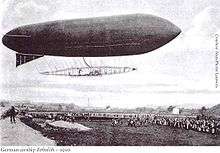Erbslöh
The Erbslöh was an airship named for the German aviation pioneer Oskar Erbslöh that was operational in the years 1909/10. In July 1910 the Erbslöh crashed near Leverkusen, killing all five people on board, including Oskar Erbslöh himself.

History
The Erbslöh was a blimp with a 27-metre (89 ft) long gondola made from ash. The trim was regulated by pumping water back and forth between two tanks in the bow and aft section of the ship so that the airship adopted a nose up or nose down attitude.
The first test flight took place on 20 August 1909. After the airship had been moved out of its hangar, the manoeuvrability was tested for about one hour at a height of 100 metres (330 ft) on the Leichlingen airship grounds. The official maiden flight was conducted on 1 December 1909, during which the airship successfully flew across Leichlingen and neighbouring towns.
On 12 December supporters of the Rheinisch-Westfälische Motorluftschiff-Gesellschaft [Rhine-Westphalian Motor Airship Society] participated in a flight. However, a transmission fault forced the Erbslöh to land at Reusrath. When the faulty parts had been repaired, the Erbslöh flew on toward Mönchengladbach on the next day. The intermediate stop over there was terminated by a storm which tore the envelope from the gondola, necessitating an extensive repairs.
Crash
On 13 July 1910, a partly cloudy day, the Erbslöh crashed near Pattscheid (today a quarter of Leverkusen). The cause that was accepted by the subsequent investigation committee was that a sudden exposure of the envelope to the sun after the ship had been flying under cloud cover and cool morning fog had heated the lifting gas, causing it to expand. The relief valves could not vent the developing excess pressure quickly enough. This allowed hydrogen to leak from the envelope and come into contact with sparks from the propulsion system, causing the gas to explode.
Witnesses on the ground only heard an explosion: the ship was not visible in the morning fog. The Erbslöh crashed in a field close to Neuenkamp. The front part of the gondola was destroyed, with the torn envelope lying across it. The crew was found dead among the debris. The airship planned to be flown over Leichlingen for only half an hour.
In addition to Oskar Erbslöh, crash fatalities included Max von Toelle, Rudolf Kranz, Hans Leo Höpp, and mechanic Joseph Spicks. A monument was erected at the "Oskar-Erbslöh-Straße" [Oskar Erbslöh Road] of Leichlingen in their memory.
Technical data
- Length: 53.20 metres (174.5 ft)
- Diameter: 10.50 metres (34.4 ft)
- Volume: 2,900 cubic metres (100,000 cu ft)
- Propulsion: 92 kW (125 hp) engine with 400 rpm, double-winged propeller with a diameter of 4.55 metres (14.9 ft)
- Maximum speed: 45 km/h (28 mph)
References
- Erbslöh, Oskar (1910). "Die Entwicklung der Luftschiffahrt in Elberfeld in den Jahren 1903 bis 1910 [The Development of airborne shipping in Elberfeld in the years 1903 to 1910]". Festschrift zur Dreijahrhundertfeier (in German). Elberfeld: J. H. Born.
- "Der Absturz des Lenkballons 'Erbslöh' [The crash of the airship 'Erbslöh']". Süddeutsche Illustrierte Zeitung (in German). 5 (31). Heilbronn: Otto Weber Verlag. 31 July 1910. pp. 483 et seq.
- Vorreiter, Ansbert (1910). Jahrbuch über die Fortschritte auf allen Gebieten der Luftschiffahrt 1911 (in German). Munich: J. F. Lehmann.
- "Das Platzen der Stoffluftschiffe" [The Bursting of textile Airships]. Im Reich der Lüfte. Deutschland voran (in German). III. Berlin: Verlag Emil Pilger Nachf. 10 August 1910.
- "Die Katastrophe von Leichlingen". Berliner Tageblatt (in German). 39 (352). Berlin. 14 July 1910.
- Hinrichs, Hans Werner (8 July 1960). "'Erbslöh' explodierte im Morgennebel". Westdeutsche Rundschau (in German). Wuppertal.
- Schmitt, G.; Schwipps, W. (1995). Pioniere der frühen Luftfahrt (in German). Blindlach: Gondrom Verlag. ISBN 3-8112-1189-7.
- Schroeder, Erich (1997). Oskar Erbslöh, ein rheinischer Luftfahrt-Pionier (in German). Cologne: Deutscher Aero-Philatelisten Club e.V.
- Boelken, Uwe (2010). Town of Leichlingen (ed.). Rheinische Luftschifffahrtsgeschichte in Leichlingen. Zur Erinnerung an den Absturz des Luftschiffes Erbslöh am 13. Juli 1910 (in German). Leichlingen.
- Dierichs, Karl-Hugo (2010). "Der Tod kam aus der Nebelwand. Erbslöhs Absturz". Bergische Blätter (in German). 33 (13): 7–9.